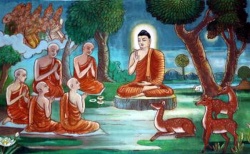The Noble Eightfold Path
The Noble Eightfold Path (Pāli: Ariyo aṭṭhaṅgiko maggo; Sanskrit: Ārya 'ṣṭāṅga mārgaḥ; Chinese: 八正道, Bāzhèngdào; Japanese: 八正道, Hasshōdō, Thai: อริยมรรคแปด, Ariya Mugg Paad, Mongolian qutuɣtan-u naiman gesigün-ü mör) is, in the teachings of the Buddha, declared to be the way that leads to the end of dukkha, or suffering. Essentially a practical guide of bringing about ethical and meditative discipline, the Noble Eightfold Path forms the fourth part of the Four Noble Truths, which have informed and driven much of the Buddhist tradition.
As the name indicates, there are eight elements in the Noble Eightfold Path, and these are divided into three basic categories as follows:
1. Right view
2. Right intention
3. Right speech
4. Right action
5. Right livelihood
- Mental discipline (Sanskrit and Pāli: samādhi)
6. Right effort
7. Right mindfulness
8. Right concentration
In all of the elements of the Noble Eightfold Path, the word "right" is a translation of the word samyañc (Sanskrit) or sammā (Pāli), which denotes completion, togetherness, and coherence, and which can also carry the sense of "perfect" or "ideal".
Though the path is numbered one through eight, it is generally not considered to be a series of linear steps through which one must progress; rather, as the Buddhist monk and scholar Walpola Rahula points out, the eight elements of the Noble Eightfold Path "are to be developed more or less simultaneously, as far as possible according to the capacity of each individual. They are all linked together and each helps the cultivation of the others".
In Buddhist symbolism, the Noble Eightfold Path is often represented by means of the Dharma wheel (Sanskrit: dharmacakra, Pāli: dhammacakka), whose eight spokes represent the eight elements of the path.
Wisdom (Prajñā · Paññā)
he "wisdom" subdivision of the Noble Eightfold Path is constituted by those elements that refer primarily to the mental or cognitive aspect of a Buddhist practitioner's practice.
Right view
Right view (samyag-dṛṣṭi · sammā-diṭṭhi) can also be translated as "right perspective" or "right understanding". This element of the Noble Eightfold Path refers explicitly to the Four Noble Truths of Buddhism, stating that these must be fully understood by the Buddhist practitioner. In the Mahāsatipaṭṭhāna Sutta, one of the Buddha Śākyamuni's discourses, right understanding is explained directly in terms of the Four Noble Truths:
And what, O bhikkhus, is right understanding? To understand suffering, to understand the origination of suffering, to understand extinction of suffering, to understand the path leading to the extinction of suffering; this is called right understanding.
In the Sammādiṭṭhi Sutta ("Right View Discourse"), Ven. Sariputta instructs that right view can alternately be attained through the thorough understanding of the unwholesome and the wholesome, the four nutriments, the twelve nidanas or the three taints. Additionally, right view is sometimes considered to encompass an understanding of the Buddhist idea of the non-permanence, or even non-existence, of the self, an idea known as anātman in Sanskrit and anatta in Pāli.
There are two stages for every stage of the eightfold path, a preliminary stage and the higher stages gradually obtained through the journey towards enlightenment. The preliminary stage of Right Views or right understanding is the knowledge of the Four Noble Truths. The higher stage requires a greater comprehension of the Four Noble Truths, which includes the knowledge and understanding of the not-self doctrine, impermanence, dependent origination, the five aggregates, "karma", rebirth, and so on.
Right intention
Right intention (samyak-saṃkalpa · sammā-saṅ kappa)]) can also be translated as "right thought", "right resolve", or "right aspiration" or "the exertion of our own will to change". This element of the Noble Eightfold Path deals, fundamentally, with the Buddhist practitioner's reasons for practicing Buddhism within an environment. It enjoins renunciation of worldly things and an accordant greater commitment to spiritual matters; good will; and a commitment to non-violence, or ahiṁsā, towards other living beings. In the Magga-vibhanga Sutta, it is simply explained as follows:
And what is right thought? Being resolved on renunciation, on freedom from ill will, on harmlessness: This is called right thought.
Ethical conduct (Śīla · Sīla)
The "ethical conduct" (Śīla) subdivision of the Noble Eightfold Path is considered the cornerstone or foundation upon which unwholesome thoughts and practices end and higher meditative states begin.
In AN 11.2 Cetana Sutta (An Act of Will) Buddha states it is virtue (without clinging to virtue) which gives freedom from remorse, which leads to joy, serenity and subsequent rapturous states of meditation.
It is in the nature of things that freedom from remorse arises in a person endowed with virtue, consummate in virtue.
In Buddhism, this is also one of the Ten Recollections along with the Triple Gem.
"There is the case where the disciple of the noble ones recollects his own virtues, thus: '[They are] untorn, unbroken, unspotted, unsplattered, liberating, praised by the wise, untarnished, conducive to concentration.'
This aspect of the Noble Eightfold Path is the most outward-oriented aspect of the Noble Eightfold Path insofar as it deals directly with a Buddhist practitioner's relationship with other members of his or her society.
Right speech
Right speech (samyag-vāc · sammā-vācā), as the name implies, deals with the way in which a Buddhist practitioner would best make use of his or her words. In the Pali Canon, this aspect of the Noble Eightfold Path is explained as follows:
And what is right speech? Abstaining from lying, abstaining from divisive speech, abstaining from abusive speech, abstaining from idle chatter: This, monks, is called right speech.
Other discourses in the Canon elaborate:
"Abandoning false speech, he abstains from false speech. He speaks the truth, holds to the truth, is firm, reliable, no deceiver of the world....
"Abandoning divisive speech he abstains from divisive speech. What he has heard here he does not tell there to break those people apart from these people here. What he has heard there he does not tell here to break these people apart from those people there. Thus reconciling those who have broken apart or cementing those who are united, he loves concord, delights in concord, enjoys concord, speaks things that create concord....
"Abandoning abusive speech, he abstains from abusive speech. He speaks words that are soothing to the ear, that are affectionate, that go to the heart, that are polite, appealing and pleasing to people at large....
"Abandoning idle chatter, he abstains from idle chatter. He speaks in season, speaks what is factual, what is in accordance with the goal, the Dhamma, and the Vinaya. He speaks words worth treasuring, seasonable, reasonable, circumscribed, connected with the goal...."
Regarding telling the truth about mundane knowledge, the Cunda Kammaraputta Sutta (AN 10.176) ascribes to the Buddha the following elaboration:
"There is the case where a certain person, abandoning false speech, abstains from false speech. When he has been called to a town meeting, a group meeting, a gathering of his relatives, his guild, or of the royalty, if he is asked as a witness, 'Come & tell, good man, what you know': If he doesn't know, he says, 'I don't know.' If he does know, he says, 'I know.' If he hasn't seen, he says, 'I haven't seen.' If he has seen, he says, 'I have seen.' Thus he doesn't consciously tell a lie for his own sake, for the sake of another, or for the sake of any reward. Abandoning false speech, he abstains from false speech."
Regarding telling the truth about spiritual knowledge, the Canki Sutta (MN 95) ascribes to the Buddha the following cautionary statements:
"If a person has conviction, his statement, 'This is my conviction,' safeguards the truth. But he doesn't yet come to the definite conclusion that 'Only this is true; anything else is worthless.'...
"If a person likes something... holds an unbroken tradition... has something reasoned through analogy... has something he agrees to, having pondered views, his statement, 'This is what I agree to, having pondered views,' safeguards the truth. But he doesn't yet come to the definite conclusion that 'Only this is true; anything else is worthless.'..."
Walpola Rahula glosses this path factor by stating that not engaging in such "forms of wrong and harmful speech" ultimately means that "one naturally has to speak the truth, has to use words that are friendly and benevolent, pleasant and gentle, meaningful and useful"
Right action
Right action (samyak-karmānta · sammā-kammanta) can also be translated as "right conduct" and, as the name implies, deals with the proper way in which a Buddhist practitioner would act in his or her daily life. In the Magga-vibhanga Sutta, this aspect of the Noble Eightfold Path is explained as follows:
And what is right action? Abstaining from taking life, from stealing, & from illicit sex. This is called right action
The Cunda Kammaraputta Sutta (AN 10.176) expands:
"And how is one made pure in three ways by bodily action?
"There is the case where a certain person, abandoning the taking of life, abstains from the taking of life. He dwells with his rod laid down, his knife laid down, scrupulous, merciful, compassionate for the welfare of all living beings.
"Abandoning the taking of what is not given, he abstains from taking what is not given. He does not take, in the manner of a thief, things in a village or a wilderness that belong to others and have not been given by them.
"Abandoning sensual misconduct, he abstains from sensual misconduct. He does not get sexually involved with those who are protected by their mothers, their fathers, their brothers, their sisters, their relatives, or their Dhamma; those with husbands, those who entail punishments, or even those crowned with flowers by another man."
Together with the idea of ahiṁsā and right speech, right action constitutes the Five Precepts (Sanskrit: pañcaśīla, Pāli: pañcasīla), which form the fundamental ethical code undertaken by lay followers of Buddhism, and which are as follows:
1. To refrain from destroying living beings.
2. To refrain from stealing.
3. To refrain from sexual misconduct (adultery, rape, etc.).
4. To refrain from false speech (lying).
5. To refrain from intoxicants, which lead to heedlessness.
Right livelihood
Right livelihood (samyag-ājīva · sammā-ājīva) is based around the concept of ahiṁsā, or harmlessness, and essentially states that Buddhist practitioners ought not to engage in trades or occupations which, either directly or indirectly, result in harm to other living beings or systems. Such occupations include "trading in arms and lethal weapons, intoxicating drinks, poisons, killing animals, [and] cheating", among others. "[B]usiness in human beings"—such as slave trading and prostitution—is also forbidden, as are several other dishonest means of gaining wealth, such as "[s]cheming, persuading, hinting, belittling, [and] pursuing gain with gain"
Mental discipline (Samādhi)
The "mental discipline" subdivision of the Noble Eightfold Path is constituted by those elements that deal with how a Buddhist practitioner can best go about shaping his or her outlook towards the world.
Right effort
Right effort (samyag-vyāyāma · sammā-vāyāma) can also be translated as "right endeavor", and involves the Buddhist practitioner's continuous effort to, essentially, keep his or her mind free of thoughts that might impair his or her ability to realize or put into practice the other elements of the Noble Eightfold Path; for example, wishing ill towards another living being would contradict the injunction—contained in the "Right thought" element—to have good will towards others, and the "Right effort" element refers to the process of attempting to root out such an ill wish and replace it with a good wish.
And what, monks, is right effort?
[i] "There is the case where a monk generates desire, endeavors, activates persistence, upholds & exerts his intent for the sake of the non-arising of evil, unskillful qualities that have not yet arisen.
[ii] "He generates desire, endeavors, activates persistence, upholds & exerts his intent for the sake of the abandonment of evil, unskillful qualities that have arisen.
[iii] "He generates desire, endeavors, activates persistence, upholds & exerts his intent for the sake of the arising of skillful qualities that have not yet arisen.
[iv] "He generates desire, endeavors, activates persistence, upholds & exerts his intent for the maintenance, non-confusion, increase, plenitude, development, & culmination of skillful qualities that have arisen: This, monks, is called right effort."
— SN 45.8
By making right effort, a Buddhist practitioner is considered to be engaging in an effort that is wholesome in terms of karma; that is, in terms of that effort's ultimate consequences to the practitioner.
The four phases of Right Effort:(in simple English)
(1) make effort to prevent the unwholesome that has not yet come.
(2) make effort to destroy the unwholesome that has come.
(3) make effort to produce the wholesome that has not yet come.
(4) make effort to cultivate the wholesome that has come.
Right mindfulness
Right mindfulness (samyak-smṛti · sammā-sati), also translated as "right memory", together with right concentration, is concerned broadly with the practice of Buddhist meditation. Roughly speaking, "mindfulness" refers to the practice of keeping the mind alert to phenomena as they are affecting the body and mind. In the Magga-vibhanga Sutta, this aspect of the Noble Eightfold Path is explained as follows:
And what, monks, is right mindfulness?
(i) There is the case where a monk remains focused on (his/her) body in and of itself ... ardent, aware, and mindful ... having already put aside worldly desire and aversion.
(ii) (He/she) remains focused on feelings in and of themselves ... ardent, aware, and mindful ... having already put aside worldly desire and aversion.
(iii) (He/she) remains focused on the mind in and of itself ... ardent, aware, and mindful ... having already put aside worldly desire and aversion.
(iv) (He/she) remains focused on mental qualities[19] in and of themselves ... ardent, aware, and mindful ... having already put aside worldly desire and aversion.
This, monks, is called right mindfulness.
This is also an important aspect of what constitutes the concept of "self" or Buddhist concept of Atman:
"And how, Ananda, is a bhikkhu an island unto himself, a refuge unto himself, seeking no external refuge; with the Dhamma as his island, the Dhamma as his refuge, seeking no other refuge?
"When he dwells contemplating the body in the body, earnestly, clearly comprehending, and mindfully, after having overcome desire and sorrow in regard to the world; when he dwells contemplating feelings in feelings, the mind in the mind, and mental objects in mental objects, earnestly, clearly comprehending, and mindfully, after having overcome desire and sorrow in regard to the world, then, truly, he is an island unto himself, a refuge unto himself, seeking no external refuge; having the Dhamma as his island, the Dhamma as his refuge, seeking no other refuge.(DN 16 Maha-parinibbana Sutta)
Bhikkhu Bodhi, a monk of the Theravadin tradition, further glosses the concept of mindfulness as follows:
The mind is deliberately kept at the level of bare attention, a detached observation of what is happening within us and around us in the present moment. In the practice of right mindfulness the mind is trained to remain in the present, open, quiet, and alert, contemplating the present event. All judgments and interpretations have to be suspended, or if they occur, just registered and dropped
Right concentration
Right concentration (samyak-samādhi · sammā-samādhi), together with right mindfulness, is concerned broadly with the practice of Buddhist meditation.
And what, monks, is right concentration?
(i) Quite withdrawn from sensuality, withdrawn from unwholesome states, a monk enters in the first jhāna: rapture and pleasure born from detachment, accompanied by movement of the mind onto the object and retention of the mind on the object.
(ii) With the stilling of directed thought and evaluation, (he/she) enters and remains in the second jhāna: rapture and pleasure born of concentration; fixed single-pointed awareness free from movement of the mind onto the object and retention of the mind on the object; assurance.
(iii) With the fading of rapture, (he/she) remains in equanimity, mindful and fully aware, and physically sensitive of pleasure. (He/She) enters and remains in the third jhāna which the Noble Ones declare to be "Equanimous and mindful, (he/she) has a pleasurable abiding."
(iv) With the abandoning of pleasure and pain...as with the earlier disappearance of elation and distress...(he/she) enters and remains in the fourth jhāna: purity of equanimity and mindfulness, neither in pleasure nor in pain.
This, monks, is called right concentration
The ninth and tenth elements
In the Great Forty Sutra (Mahācattārīsaka Sutta), which appears in the Pāli Canon, the Buddha explains that cultivation of the Eightfold Path leads to the development of two further stages once enlightenment has been reached. These also fall under the category of paññā and are Right Knowledge (sammāñāṇa) and Right Liberation (or Right Release; sammā vimutti). Some consider Right Association as an implicit ninth aspect of the Path.
To further the foregoing, Bucknell & Martin (1986: p.6) state:
The Eightfold Path as described gives an impression of orderliness and completeness. However, closer study of the texts indicates that it is not after all a complete account of Gotama's course of practice. A number of suttas describe a Tenfold Path. This differs from the Eightfold Path in having two further stages following right concentration, namely right insight or knowledge or wisdom (sammā ñāṇa) and right liberation (sammā vimutti). These two extra stages are nowhere described, nor is any explanation given for their frequent omission. The tenth state, right liberation, is presumably to be equated with the final goal, nirvāṇna. However, the ninth stage, right insight, which appears from its position in the list to be of crucial importance, remains unaccounted for.
The Noble Eightfold Path and cognitive psychology
In the essay "Buddhism Meets Western Science", Gay Watson explains:
Buddhism has always been concerned with feelings, emotions, sensations, and cognition. The Buddha points both to cognitive and emotional causes of suffering. The emotional cause is desire and its negative opposite, aversion. The cognitive cause is ignorance of the way things truly occur, or of three marks of existence: that all things are unsatisfactory, impermanent, and without essential self.
The Noble Eightfold Path is, from this psychological viewpoint, an attempt to change patterns of thought and behavior. It is for this reason that the first element of the path is right understanding (sammā-diṭṭhi), which is how one's mind views the world. Under the wisdom (paññā) subdivision of the Noble Eightfold Path, this worldview is intimately connected with the second element, right thought (sammā-saṅkappa), which concerns the patterns of thought and intention that controls one's actions. These elements can be seen at work, for example, in the opening verses of the Dhammapada:
Preceded by perception are mental states,
For them is perception supreme,
From perception have they sprung.
If, with perception polluted, one speaks or acts,
Thence suffering follows
As a wheel the draught ox's foot.
Preceded by perception are mental states,
For them is perception supreme,
From perception have they sprung.
If, with tranquil perception, one speaks or acts,
Thence ease follows
As a shadow that never departs.
Thus, by altering one's distorted worldview, bringing out "tranquil perception" in the place of "perception polluted", one is able to ease suffering. Watson points this out from a psychological standpoint:
Research has shown that repeated action, learning, and memory can actually change the nervous system physically, altering both synaptic strength and connections. Such changes may be brought about by cultivated change in emotion and action; they will, in turn, change .

















